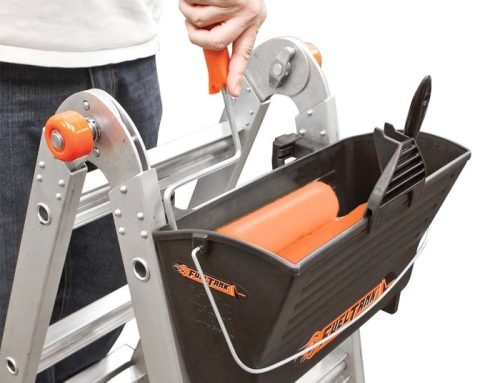Humans use ladders for all sorts of purposes, one being to rescue or reach animals that have become stranded, or alternatively, in the case of angling, to get a good position to cast from. The Lahontan cutthroat trout is particularly prized among competitive and keen anglers, due to the size and ferocity of the fish. Once teeming in the waters of the Truckee River, Lake Tahoe and Pyramid Lake in Nevada, these fish were pushed to the brink of overfishing and now are a rare site when they congregate in these waters. It was even thought that the fish were extinct in the lake as recently as 1943, but since then a programme of genetic engineering and the transportation of juvenile fish from waters where there are plenty, to waters that need restocking, has restored the natural population to a sustainable level. The scarce legacy of the animals and the irregularity with which they are spotted in any one location means that anglers will try almost anything to catch one, before releasing it back into the wild of course.
The secret that the locals have is to use a stepladder in the lake to gain extra height at a location you could not reach without being in the water. As the water becomes deeper the further in you go, there's a sweet spot where ladders can be positioned in Pyramid Lake that can still be reached with chest waders but is far enough into the water to get close enough to the fish to cast a perfect line. We'd never suggest using a ladder in the water – after all we know that setting a ladder up on wet, rocky ground is asking for trouble, but these anglers clearly take precautions to set the ladders up in the most stable way they can. Falling from a ladder in the water won't result in broken bones or scrapes, so it's actually a little safer than it first appears. Now, if you see a line of stepladders at a popular fishing spot you'll know what's going on.
Rescuing animals is also a task which often requires a ladder, whether it's a cat stuck in a tree or a bear cub stranded in a bin, ladders are invaluable in saving wildlife. The RSPCA called Devon and Somerset fire crews to a property where a Tawny Owl had become stuck and distressed in a chimney. Flexible cameras, chimney brushes and the ladders were used to assess the situation and then rescue the owl, who was no doubt relieved to be freed from the dark, small chimney flue. The camera was used to locate the owl and ensure that it did not sustain any damage from the equipment used, while the aerial ladder and an extension ladder were deployed to assist in the rescue.
In some cases, birds use ladders to make their homes. One memorable case was that of a nesting pair of blackbirds who had started building several nests in the spaces created by an extension ladder hanging horizontally on their garden wall. Birds are not great at differentiating between similar looking spaces, so they ended up with nests in various stages along the ladder, but one was successfully used to hatch their chicks.
The owners of a stepladder in Oak Park, Illinois, found out the hard way that birds will make their nests in any place that seems safe. After using the ladder for the last time over winter, the owner Dan Haley left it leaning against the house rather than putting it away in the garage at the front of the property. A pair of nesting robins spotted this excellent place to build a nest and set to work creating a snug and safe little home for their young. This activity wasn't noticed until the nest was complete and the parents were taking turns guarding and incubating the eggs, so the Haley family had to wait until the baby birds were born and had fledged the nest before they could use the ladder again. The Haley’s got the magical experience of watching young birds grow and fly for the first time, which is priceless. It might have been a great excuse to postpone some DIY tasks at the time, but we do think Dan will think twice about leaving his ladder outside now!






Leave A Comment
You must be logged in to post a comment.